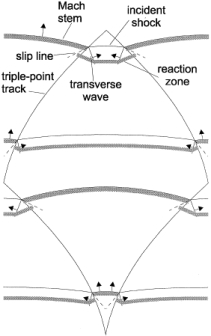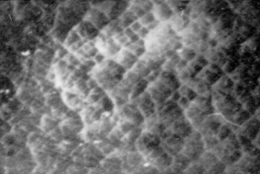
|
BRHS /
Chapter 1Detonation front structureStandard practice of evaluation possible hazards, which can come from detonation precesses is usually based on the theory of sbased on the theory of stady state one-dimensinal detonation. The predictions of such theory are well-known and usually can have sufficient accuracy to provide necessary information for industrial designs.  Fig. 1. Detonation front structure. However there are numerous examples demonstrating non-statinary and multi-dimensional nature structure of the detonations. These features can affect the maximum local pressures during detonation process and therefore can be important from the point of view of safety aspects for industrial applications. Detonation waves in the mixtures, which are far enough from detonation limits, have internal multi-dimensional structures. Already classical works on structure of detonation waves, e.g. (Woitsekhovski, 1960, Strehlow, 1970a, 1970b, 1970c), allowed to discover different type of detonation waves:
In case of lean or reach mixtures, which are close to their detonation limits, detonations occur usually exhibiting characteristics of the second or third types. Unfortunately, most of the experimental work was performed for the mixtures far from detonation limits, and detonations of marginal mixtures are not studied in full volume. Note that the role of front structure, as a rule, appears to be more significant in case of lean mixtures detonations, which are typical for industrial accidents. Multi-dimensional structure of the detonation front includes leading shock wave and a number of transverse waves, which propagates perpendicular to the leading shock, reflecting from each other and from bounding walls. The surface of the leading shock consists of the sequence of convex parts, which start chemical reaction, and concave parts which are fast decaying waves. Additional reaction zones are located behind the transverse waves where the reaction completes. Detonation cell sizeIn Figure 1 (Gavrikov, 2000) a diamond-shaped form demonstrated a typical track of triple points intersecting shock waves. Such track is called detonation cell and can be easily obtained experimentally on sooted sur-faces located in detonating gases. These cells form a cellular structure observed experimentally, and are characterized by their two lengths: longitudinal size L and transverse size S. These two lengths are varying depending on type of burnable gase and intial conditions, however the relation S ≈ 0.6 · L or S \approx 0.6 \cdot L are kept usually constant. \begin{equation} S \approx 0.6 \cdot L \end{equation}  Fig. 2. Typical example of the soot \\ track for H2 cellular structure. In Figure 2 (Kuznetsov, 2000, 2002) an example of soot track cellular structure produced by detonation of stoichiometric hydrogen-air mixture is shown. Average transverse cell size S ≈ 1 cm. For such mixture typically irregular detonation cellular structure is realized. The detonation cell size is kept constant for the given components for the same initial condition and depends only on the mixture composition, and therefore is often used as a mesure of mixture reactivity. Usually the detonation cell size reaches its minimum at the stoichiometry composition and grows for leaner and reacher mixtures. ReferencesV. V. Voitsekhovski (1960) Front structure of detonation in gases (in Russian), Publ. AN SSSR. |